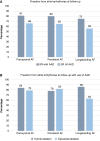Epicardial and hybrid surgical ablation of atrial fibrillation: 1-year follow-up outcomes of the EORP EHAFA registry
- PMID: 40971527
- PMCID: PMC12449207
- DOI: 10.1093/europace/euaf196
Epicardial and hybrid surgical ablation of atrial fibrillation: 1-year follow-up outcomes of the EORP EHAFA registry
Abstract
Aims: Stand-alone minimal invasive epicardial and hybrid atrial fibrillation ablation (EHAFA) has evolved to a recognized treatment option in challenging patients. The EHAFA registry was initiated to describe the applied diagnostic and therapeutic approaches used in routine practice for these procedures, as well as the outcomes in terms of rhythm, symptoms, and complications.
Methods and results: Between January 2016 and March 2018, patients who underwent an EHAFA procedure for all types of atrial fibrillation (AF) were consecutively enrolled in the international, prospective, observational EHAFA registry. Follow-up occurred after 1 year. A total of 468 patients were enrolled from 17 centres in 10 countries. Stand-alone ablation (n = 464) was performed epicardially in 47% (n = 220) or as epi-/endocardial hybrid in 53% (n = 244). The predominate type of AF was non-paroxysmal in 74% (n = 342), and 36% (n = 166) of patients had failed previous catheter ablation. The main lesion sets applied consisted of pulmonary vein isolation (99%, n = 460) and isolation of the left atrial (LA) posterior wall (82%, n = 383). In 82% (n = 382), the LA appendage was managed. The overall in-hospital major complication rate was 8.2% (n = 38/464). Freedom from atrial arrhythmias > 30 s with and without antiarrhythmic drug usage was 79% and 64% (n = 279/353, n = 223/351, respectively). The EHRA score at follow-up was clearly reduced compared to preoperatively (EHRA I: 72%, n = 233/325, vs. 3%, n = 14/464).
Conclusion: This international registry revealed good rhythm control efficacy for epicardial and hybrid AF ablation in patients with advanced AF, leading to improvement in AF-related symptoms. However, a certain associated complication rate needs to be considered.
Keywords: Atrial fibrillation; Epicardial ablation; Hybrid ablation; Registry; Surgical ablation.
© The European Society of Cardiology 2025.
Conflict of interest statement
Conflict of interest: C.B.L. declares consulting fees from Medtronic, Boston Sci, Philips, Cathprint, Abbott, and Milestone; payment or honoraria for lectures, presentations, speakers bureaus, manuscript writing, or educational events from Medtronic, Boston Sci, Philips, Cathprint, Bayer, and Sanofi; participation on a data safety monitoring board or advisory board for Medtronic, Boston Sci, and Abbott; and leadership role as an ESC Councillor, EHRA Committee member, Swedish Society Cardiology Member, and chair ARRH group. K.N.D. declares consulting fees from Medtronic (advisory board) and AtriCure (consultant); honoraria for lectures for AtriCure; and support for attending meetings and/or travel for AtriCure. L.M. declares grants to his institution, consulting fees from Abbott Medical, Medtronic, Boston Scientific, Biotronik, and Johnson & Johnson; payment or honoraria from Abbott Medical, Medtronic, Boston Scientific, and Johnson & Johnson; payment for expert testimony and support for attending meetings and/or travel from Abbott Medical and Medtronic; and stock or stock options from Galgo Medical S.L. and Corify Care, S.L. M.L.M. declares consulting fees from AtriCure. All other authors have nothing to declare.
Figures



References
-
- Thrall G, Lane D, Carroll D, Lip GYH. Quality of life in patients with atrial fibrillation: a systematic review. Am J Med 2006;119:448.e1–e19. - PubMed
-
- Crandall MA, Horne BD, Day JD, Anderson JL, Muhlestein JB, Crandall BG et al. Atrial fibrillation significantly increases total mortality and stroke risk beyond that conveyed by the CHADS2 risk factors. Pacing Clin Electrophysiol 2009;32:981–6. - PubMed
-
- Wyse DG, Waldo AL, DiMarco JP, Domanski MJ, Rosenberg Y, Schron EB et al. A comparison of rate control and rhythm control in patients with atrial fibrillation. N Engl J Med 2002;347:1825–33. - PubMed
-
- Hsu LF, Jaïs P, Sanders P, Garrigue S, Hocini M, Sacher F et al. Catheter ablation for atrial fibrillation in congestive heart failure. N Engl J Med 2004;351:2373–83. - PubMed
Publication types
MeSH terms
Grants and funding
LinkOut - more resources
Full Text Sources
Medical

